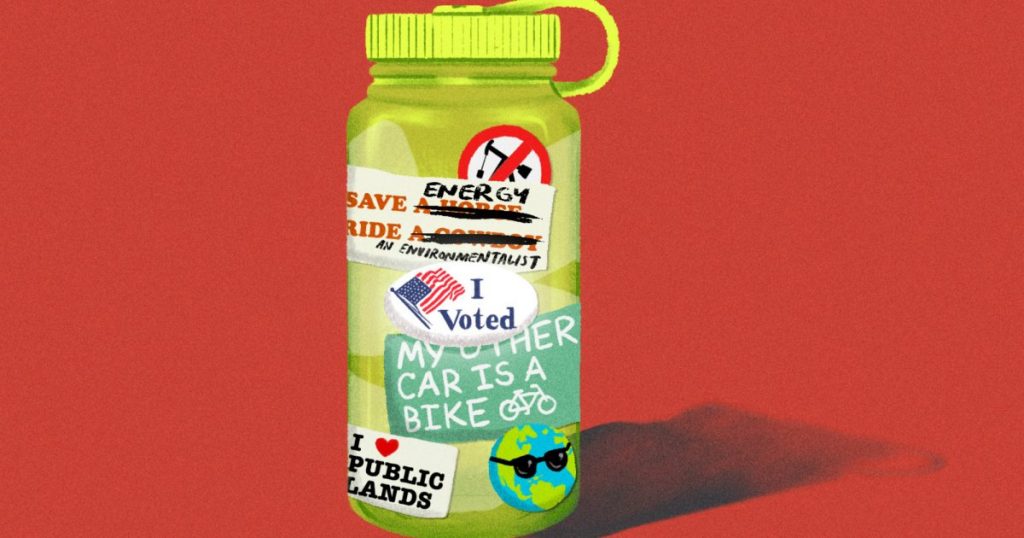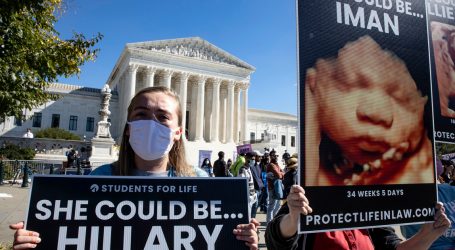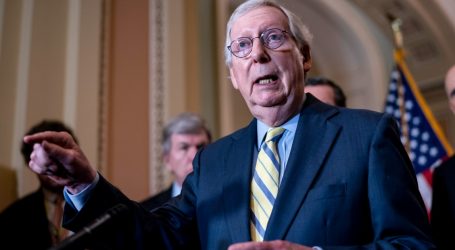The Environmental Voter Project Knows Who You Are, and How to Trick You Into Saving the Planet
Amelia Bates/Grist
Looking for news you can trust?Subscribe to our free newsletters.
This story was originally published by Grist and appears here as part of the Climate Desk collaboration.
Mary Elizabeth, a redheaded woman in exercise clothes, is holding an extremely bald, blubbery baby when she answers her door. She’s smiling through the exhaustion of new parenthood and is almost gushingly friendly. She wants to let the Environmental Voter Project intern on her doorstep know that she really appreciates what her visitor is doing, really. And yes, of course she’s going to vote in the upcoming election, it’s so important! But she can’t really talk right now.
I’m standing on the porch with said intern—Adrienne La Forte, a junior at Tufts University who looks like a cross between Zooey Deschanel and Frances Bean Cobain, but in Tevas—to get that exact promise. So we don’t really need more of Mary Elizabeth’s time. We’re done here.
Chasing more people for the same pledge, we continue down this street in the Boston neighborhood of Jamaica Plain and ascend the steps belonging to Carlos the piano player. He’s not home. We ring the doorbell belonging to Alex the ballerina. She’s not there either.
Each of these people is an environmentalist—at least, according to the algorithm that generated the canvassing lists we’re using to guide us to each door to knock on. That algorithm analyzes a combination of consumer and demographic data to identify Mary Elizabeth and Carlos and Alex as people who probably consider the climate and environment among their top political priorities and may need to be encouraged to vote. According to the Environmental Voter Project, it is roughly 89 percent accurate. We know with 100 percent accuracy—because it’s public information—that Mary Elizabeth and Carlos and Alex have missed the last few elections. La Forte is coming by to urge them to turn up for the September 4 primary here in Massachusetts.
Environmental Voter Project intern Adrienne La Forte waits for a resident to answer the door in the Boston neighborhood of Jamaica Plain.
Eve Andrews/GristWhen she wasn’t working at Anthropologie to pay rent, La Forte went door to door all summer long to ask each of these people ID’d by the algorithm whether they plan to vote in the upcoming primary. If they do, would they mind signing a pledge to promise to follow through? She’ll mail it to their house later, ahead of the election, just as a nice reminder.
It all sounds pleasant enough, but it’s actually psychological manipulation. The idea behind her request is to tap into these voters’ desire to project the best versions of themselves—that is to say, people who are committed, engaged, and follow through on a promise.
The EVP sees itself as a field lab, testing and honing the best ways to get environmentalists to appear at the polls. That’s it. They offer no arguments about why environmental issues matter, no attempts to convince their targets why voting is important, no pressure to vote for any particular candidate. Just: Will you vote? Promise? OK. The reason why is that environmentalists are very bad at voting. In the 2014 midterm election, for example, 44 percent of registered voters showed up. Just 21 percent of registered voters who consider themselves environmentalists did.
The EVP headquarters is merely a modest shared office in downtown Boston, peopled on any given day by three full-time staffers and roughly half a dozen interns. It also counts on a coordinated team of volunteers scattered across the nation, from the Boston HQ to Boulder.
But its goal is outsized: It plans to save the planet by getting environmentalists to be their ideal selves. Which is to say, environmentalists who vote.
The canvassing is just part of it. Getting people to the polls, for the EVP, is an integrated operation including phone calls, text message campaigns, direct mail, email, and online ads. The wording and formatting of each of these are meticulously tested—that’s the “lab” part of the operation.
You will find nary a mention of “environment” in anything the EVP does, except for the organization’s name. That is by design. “All the messaging we test is simply focused on one thing: What will increase the likelihood of voting?” EVP founder Nathaniel Stinnett says. “Talking about intricacies of candidates or races or issues doesn’t get the best results, so we don’t.”
For instance, in Tuesday’s Massachusetts primary, traditional political observers are watching upstart congressional contenders like Gamergate heroine Brianna Wu, and Ayanna Pressley— the first woman of color elected to Boston’s City Council. Pressley is now challenging a long-stagnant seat in the House and just netted a coveted endorsement from the Boston Globe. But at EVP, you’ll never hear those names or those of their opponents. Instead, project employees talk about the fact that the election date was moved from Sept. 18—the eve of Yom Kippur, the Jewish holiday if you’ve got some sins to atone for—to the Tuesday after Labor Day weekend.
Between the timing and it not being a presidential election year, the primary is likely to be pretty dead. But for Stinnett, it’s a golden opportunity to get long-absent voters to the polls and attract some notice from those in office. “We love elections like this!” he says, with glee that approaches mania.
If you don’t vote, goes Stinnett’s rationale, politicians don’t care about what you think. So if you’re the most fervent environmentalist in the world but you never appear at the polling station, no one in Congress will pay two seconds of attention to you or your concerns about climate change or conservation or clean energy.
But if you do vote—especially in the sleepiest, least sexy elections imaginable, like this midterm primary in Massachusetts—Stinnett is certain politicians will start to pay attention to what you care about. And they’ll push for laws and policies that reflect your beliefs.
In a nutshell, that is the goal of EVP and its tests and messaging campaigns and esoteric techniques. “Climate change is not a small issue—it’s an existential crisis,” Stinnett says. “And not using cutting-edge scientific tools to try to solve this problem is inexcusable.”
The tactic of getting people to the polls by playing on their psychological habits, biases, and quirks is now roughly 15 years old. In 2004, then-Harvard Business School graduate student Todd Rogers became an acolyte of Richard Thaler, a pioneer of behavioral economics and subsequent Nobel laureate. Rogers was one of the first to meaningfully apply behavioral psychology to practical politics, says Sasha Issenberg, author of The Victory Lab, the definitive book on data-driven political campaigns.
In 2006, Thaler informally invited Rogers into a group of now-legendary social scientists, which included, among others, Richard Cialdini, a famous scholar of the psychology of persuasion. The group’s members realized that the enormous body of research on human decision-making had never been applied to voter psychology, Issenberg says, so they set out to correct that oversight.
The following year, Rogers founded the Analyst Institute, a data-driven, behavioral psych-oriented political consultancy. It targeted voters on behalf of the AFL-CIO, and later consulted for other politically progressive organizations, including the 2012 Barack Obama presidential campaign (more on that shortly.) Meanwhile, Rogers—now a professor of public policy at Harvard — continued to publish research on voter psychology with other academics.
A 2009 Rogers study found that “high turnout” messaging (i.e., telling voters “Everyone is voting tomorrow!”) yielded better results than low-turnout alternatives (i.e., telling them “No one is voting tomorrow—so you must!”). In 2010, his research suggested that asking how a prospective voter will go about voting (such as, “Do you have a voting plan?”) was more effective than simply asking “Are you going to vote?” In 2016, he found evidence that the promise of a follow-up (“Did you vote yesterday?”) would increase the likelihood that a person would actually head to the polls—and be able to answer in the affirmative.
The pledge card the Environmental Voter Project asks the prospective voters it targets to fill out. The EVP mails the cards back to those who complete them as reminders to vote.
Eve Andrews/GristThere are predictable and consistent reasons that people vote, Rogers and other social scientists found: We don’t want to disappoint our peers, family, and friends. We want to live up to some ideal of ourselves, to be the type of person our teachers and parents coached us to be—one who participates in society and civic life.
The reasons we don’t vote: We forget. We had to work a double shift. We don’t have anyone to watch our kids for half an hour and don’t want to deal with dragging them to an un-air-conditioned elementary school. We don’t actually know who any of the candidates are—and feel bad about not knowing. Or our state government may have methodically set up barriers like ID laws and voter purges to keep us from the polls.
The essential point is that few of these obstacles have to do with a deliberate refusal to vote. They’re mostly behavioral—which means they can be shifted simply by changing how people act, rather than how they think.
In 2012, the Obama campaign contracted the Analyst Institute to help turn out voters for the then-president’s reelection effort. The Institute’s staffers shaped the messaging, but more importantly, they introduced a methodology to test its effectiveness. The approach was twofold: First, they randomly tested their communications on a massive group of subjects, sending out different types of persuasive mailings and then following up with surveys to assess each one’s impact. Second, they figured out how to use demographic and consumer data to identify a set of persuadable potential voters.
On November 6, 2012, when Barack Obama was reelected as president of the United States, his campaign attributed the narrow margin of victory in part to that data-enabled targeting.
Directing this attention toward people who typically don’t vote, however, is a relatively new development. New York State congressional candidate Alexandria Ocasio-Cortez has, again and again, attributed her recent surprise success in the Democratic primary to the fact that she pays attention to the non-voters who so many candidates ignore. As cofounder of Data For Progress Sean McElwee recently pointed out, non-voters who are also people of color are more likely to support progressive policies in general, including legislation necessary for environmental benefit, such as regulating carbon emissions.
As Stinnett repeats over and over again, the organization does not target groups. It is more specific than that. It is targeting Mary Elizabeth, Carlos, and Alyssa in Jamaica Plain. And if Mary Elizabeth, Carlos, and Alyssa show up to the polls, that’s all that matters.
“[We’re] greatly appreciative of EVP’s work,” says RL Miller, political director of Climate Hawks Vote, an organization that works to elect pro-climate action candidates. “To paraphrase Ocasio-Cortez, stop chasing voters who swing from left to right, and instead focus on swinging non-voters into becoming voters.”
In those words, it sounds straightforward. But actually putting the idea into practice has been years in the works.
Nathaniel Stinnett is an energetic man—so energetic, it’s almost intimidating. With deep-set steel-blue eyes and nary a hair on his head, he looks like Lex Luthor attempting to pass as a Somerville accountant, complete with Red Sox ball cap, gingham shirt, and chinos.
He laser-focuses his intensity on a conference table surrounded by interns, peering at each one by one, as he offers a seminar on the psychology behind EVP’s strategy. Most of the interns come from Boston-area colleges. Their laptops and Nalgenes are festooned with exactly the stickers you might expect from a roomful of environmental nonprofit interns: “I





